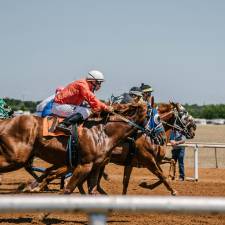The Geelong and Melbourne Cup races have been completed, with two of Australia's most interesting horse races having been contested. Runaway took the win from the Geelong Cup, while Cross Counter got the job done in the Melbourne Cup. Those results made for the seventh straight year where the winner of the Geelong and Melbourne Cup were different horses, begging the question of whether or not the winner of those two races will be the same within the same year ever again.
As a bit of background, only three horses in the history of the sport have managed to win both the Geelong and Melbourne Cup within the same year. Media Puzzle was the first horse to pull off the feat by doing so in 2002 and was followed by Americain in 2010 and Dunaden in 2011. Dunaden had an even more special run, as the horse managed to take home the Geelong Cup, Melbourne Cup, and Hong Kong Vase within the same year. Runaway got the job done in Geelong, but couldn't pull off the double.
Needless to say, winning both of these races is rare, but just how rare is really put into perspective when you consider how long both of those races have been run. The Melbourne Cup was first run in its earliest form in 1861, while the Geelong Cup was first run in 1872. That means that there has been nearly a century and a half worth of these races, with only three horses managing to win both of them in the same year, making it one of the sport's truly unique accomplishments.
Perhaps the biggest obstacle separating horses from pulling off this accomplishment is that horse racing as a whole has become more specialized. The sport is so full of horses, trainers, and programs that unless a horse is special, it isn't always likely that it will be able to make the jump from a G3 race like the Geelong Cup up to a G1 race like the Melbourne Cup. Either a horse isn't good enough to go from the G3 to the G1, or it is too good to want to take the step down from the G1 to the G3. There are surely some exceptions, as evidenced by the three horses who did the double, but even seeing horses who compete in both races isn't a given each year.
For example, in the 2018 edition of the Melbourne Cup, only three horses that competed in the Geelong Cup made it into the field of 24 races. 2018 Geelong Cup winner Runaway took part in the Melbourne Cup, but he finished all the way back in 19th place in the race. Even getting to the Melbourne Cup was an accomplishment for Runaway, as it was thought after the Geelong Cup that he needed quite a bit to go his way just to qualify for the field.
The second horse from the Geelong Cup field to race in Melbourne was Pinche, who had a consistently strong showing in both races. Pinche finished third in the Geelong Cup and went off at 20-1 odds in the Melbourne Cup. Despite not being one of the favourites in the race, the Melbourne Cup saw a fourth place finish, which may have been even more impressive than the top-three ending in Geelong given how difficult the field is at the G1 spectacle.
Finally, there was Zacada, who wasn't overly impressive in either of its appearances in these two Australian racing season staples. Zacada finished in 12th place in Geelong and was tied as the biggest longshot in the Melbourne Cup at a massive 100-1 underdog. And it didn't ever look like there was a chance for this longshot to win the race, with Zacada finishing in 13th place in Melbourne.
Runaway managed to exceed expectations in the Geelong Cup, as Geelong Cup betting tips from Oddschecker didn't rate Runaway as one of the top contenders to win the race. But even a horse that was capable of going above and beyond what was expected of it wasn't deemed to be a serious contender at the biggest race on the Australian racing calendar.
The Melbourne Cup, by the way, was wild even by the standards of that race. It started with the lowest attendance figure for the race since 1995, with under 84,000 people in attendance for what is known as one of the biggest days of the year in Australian racing. But the prize money was higher than it had ever been, with over $7,300,000 in prize money awarded, compared to the $6,200,000 in prizes in the six years prior.
It also ended on a sour note, with The Cliffsofmoher being put down after suffering a shoulder fracture during the race that it was deemed unable to recover from. The horse was tabbed as one on the short list of contenders to win the race, being set at 12-1 odds before the start of the action. Obviously, the situation is sad no matter what the skill level of the horse was, but the fact that a skilled horse had something terrible happen was upsetting to casual and experienced horse racing fans alike.
Horse racing in Australia is in an interesting place as a whole right now, given that the sport is growing around the world in a major way, but the sport is also becoming easier to access on a global level. Instead of having to go to a local track to watch an event, fans of horse racing can go to a television or streaming device in order to watch events happening around the world via dedicated outlets. That could have an impact on attendance in future horse racing events both in Australia and abroad.
However, the more important impact could be on the horses and their teams, in terms of what events they are taking part in and where the money is in horse racing. There is a lot of money to be had in events around the world now, whereas there was clearly less of it in the past. Additionally, with the influx of horse racing media, there is much more exposure for a horse that can win races if they can win in regions of the world like the Middle East where horse racing was not previously as popular on such a scale.
That could change which races horses are entered into. In turn, that could dissuade horses from trying to take part in the Geelong and Melbourne Cups in the same year, with more lucrative G1 races with which they can fill their calendars.
Find out more about Racing Events and all types of Horse Racing right here on EIE.













